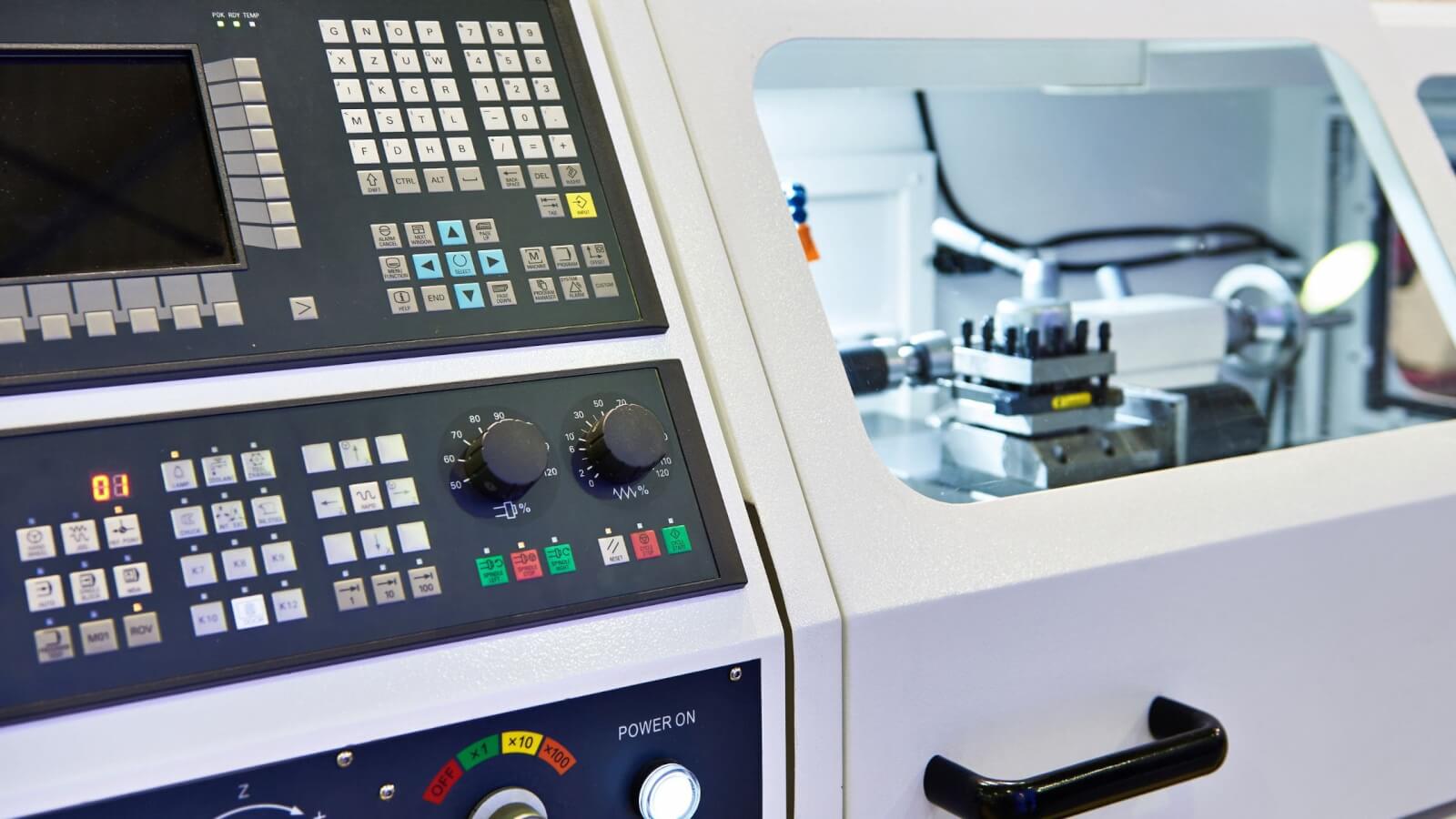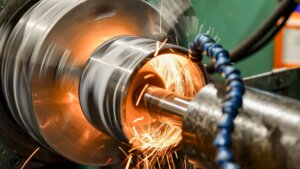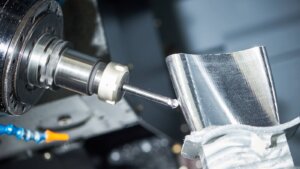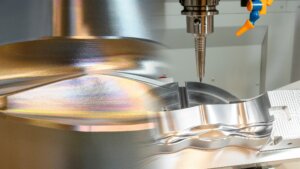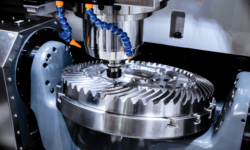When delving into the world of machine tools, the lathe stands out as a fundamental and versatile device. Its ability to shape materials into precise forms has been pivotal in numerous industries, from intricate watchmaking to robust aerospace components. This extensive guide aims to unravel the intricacies of the lathe, exploring its history, functioning, types, and its indispensable role in modern manufacturing.
What is a Lathe?
A lathe is an incredibly versatile and the most important machine tool used in turning. It operates by rotating a workpiece on its axis while stationary cutting tools shape it to the desired form. This action enables the creation of objects with symmetrical profiles about an axis of rotation, ranging from simple wood bowls to complex metal parts.
Short History of Lathe
Embarking on a journey through the evolution of lathes reveals a fascinating intersection of creativity, engineering, and historical progress. This incredible machine tool, integral to shaping a multitude of materials, has a rich history that mirrors the advancements in human ingenuity and technology.
Who Invented the Lathe?
The modern lathe, a cornerstone of today’s machine shops and a testament to human innovation, was significantly refined by Henry Maudslay in the early 19th century.
His work laid the groundwork for precision metalworking and earned him the title of the “father of the modern lathe.” This development marked a pivotal moment in industrial history, catalyzing advancements in manufacturing and machining processes.
Lathe History and Developments from Ancient Times to Modern Days
The story of the lathe is a chronicle of human progress, from rudimentary beginnings to the sophisticated CNC lathes of today. Here’s a timeline highlighting key milestones:
- BC: The inception of the lathe is traced back to ancient civilizations. In Egypt, remnants of wooden artifacts suggest the use of rudimentary lathes, possibly driven by a bow, for turning wood. These ancient lathes laid the foundation for a technology that would evolve significantly over millennia.
- Middle Ages: The Middle Ages saw the introduction of the treadle lathe, a significant leap from its primitive predecessors. Operated by foot, this lathe allowed craftsmen greater control and precision. Its mechanism involved a pedal that, when pressed, would rotate the workpiece through a system of cords and pulleys. This era also witnessed the growth of lathe use in metalworking, with the development of more durable and capable tools.
- Renaissance Period: During this era, the lathe became more sophisticated. Innovations included the addition of a tool rest, allowing for steadier and more precise cutting. The period was marked by an increased understanding of mechanics and a growing interest in machine tools, setting the stage for future developments.
- 18th Century: The industrial revolution brought about a transformative phase in the history of the lathe. The introduction of metal lathes, powered initially by water wheels and later by steam engines, marked a significant advance in the machining process. This period saw the development of more complex lathes capable of cutting threads, turning metal, and producing more intricate and precisely shaped workpieces.
- Early 19th Century: Henry Maudslay, a key figure in the industrial revolution, made a groundbreaking contribution by developing the screw-cutting lathe. This innovation allowed for the consistent and accurate cutting of screw threads, revolutionizing precision engineering and manufacturing processes. It set new standards for machining accuracy and repeatability.
- Late 19th Century: The integration of electric motors into lathes marked another revolutionary phase. This advancement enhanced efficiency and power, allowing for faster and more consistent operations. The electric motor replaced manual and steam-powered systems, leading to the development of more complex and versatile lathes.
- 20th Century: The 20th century witnessed perhaps the most significant evolution in lathe technology with the advent of CNC (Computer Numerical Control) lathes. These modern lathes, equipped with computer-controlled systems, brought unparalleled precision and complexity to machining tasks. The CNC technology enabled the automation of operations, allowing for intricate designs and repeatable processes at an industrial scale.
- Late 20th and Early 21st Century: The late 20th and early 21st centuries saw further refinements in lathe technology. Advances in digital technology and the advent of more sophisticated CNC systems have enabled lathes to perform a wide range of complex and precise operations. The development of specialized lathes, such as vertical lathes for handling large, heavy workpieces and Swiss-type lathes for precision small part machining, further expanded the capabilities of this versatile machine tool.
How does Lathe work?
Understanding how a lathe, an incredibly versatile machine tool, operates is crucial for anyone interested in the world of machining. Let’s break down the operation of a modern-day engine lathe step by step, keeping in mind that this explanation focuses on standard lathes rather than CNC lathes.
- Preparation and Setup: Before any lathe operation, it’s essential to prepare the machine and workpiece. This includes ensuring the lathe machine is clean and all components, such as the lathe bed, headstock, and tailstock, are properly aligned. The workpiece is then securely mounted to the lathe. This could be done between centers in the headstock and tailstock, or more commonly, by attaching it to a chuck or faceplate connected to the spindle.
- Selecting and Installing the Cutting Tool: A suitable cutting tool is chosen based on the material of the workpiece and the desired operation. The tool is then securely fixed onto the tool post or a tool holder, ensuring it’s correctly positioned and at the appropriate distance from the workpiece.
- Setting Spindle Speed: The spindle speed is a critical factor in lathe operations. It must be set according to the type of material and the specific cutting operation. The lathe’s electric motor powers the main spindle, dictating the rotational speed of the workpiece.
- Engaging the Feed: After setting the spindle speed, the next step is to engage the feed. The feed moves the cutting tool along the longitudinal direction of the lathe bed or in a cross-slide motion, allowing for precision cutting. This movement can be manually controlled or set to move automatically at a steady rate, determined by the lead screw and feed rod mechanisms.
- Performing the Cutting Operation: The cutting process begins by bringing the tool into contact with the rotating workpiece. The lathe removes unwanted parts from the workpiece, shaping it as it rotates. Operations such as turning, facing, grooving, and threading are performed by moving the tool against the workpiece in various directions and depths.
- Monitoring and Adjusting: Throughout the operation, it’s crucial to monitor the cutting process and make necessary adjustments. This includes checking the shape and dimensions of the machined workpiece, ensuring the cutting tool remains sharp and effective, and adjusting the feed rate and spindle speed as needed.
- Finishing and Inspection: Once the machining operation is complete, the workpiece is usually inspected for accuracy and finish. Additional steps like sanding or polishing may be performed on the lathe to achieve the desired surface finish.
What are the Key Components of a Lathe?
A lathe, an incredibly versatile machine tool, is comprised of several key components, each playing a vital role in its operation. Understanding these parts is crucial for anyone looking to master lathe work or understand how these machines contribute to various machining processes.
Headstock
The headstock is a critical component of the lathe, located at the machine’s left end. It houses the main spindle, gears, and often the motor that drives the spindle. The primary function of the headstock is to hold and rotate the workpiece. The speed at which the spindle turns can often be adjusted, providing control over the cutting speed. This part of the lathe is essential for maintaining precision and stability during the machining process.
Tailstock
Function: Positioned opposite the headstock, the tailstock supports the other end of the workpiece.
Role: It’s commonly used to hold tools like drills or reamers for operations such as drilling. The tailstock can be moved along the lathe bed and clamped in position, providing additional support for longer workpieces. It’s adjustable, allowing it to be set to the required length, ensuring that the workpiece is held securely and accurately.
Bed
Function: The bed of the lathe serves as a robust base that supports the major components of the machine, including the headstock, tailstock, and carriage.
Role: It ensures alignment and precision by holding these components in place. The bed must be extremely stable and rigid to prevent any movement or vibration during operation, which could affect the accuracy of the work.
Carriage
Function: The carriage slides along the bed and is responsible for carrying the cutting tool.
Role: It facilitates precise lateral (side to side) and longitudinal (back and forth) movements for cutting. The carriage is typically controlled by a handwheel or a motor, allowing for smooth and accurate positioning of the cutting tool against the workpiece.
Lead Screw
Function: A long threaded shaft that runs parallel to the bed.
Role: The lead screw is crucial for precise threading operations and movement of the carriage. It works in conjunction with the carriage’s feed mechanism, allowing for controlled and precise cuts, especially in threading operations.
Feed Rod
Function: The feed rod, often running alongside the lead screw, also runs parallel to the bed.
Role: It powers the carriage movement for non-threading operations. This rod is essential for the consistent movement of the carriage during turning operations, ensuring smooth and even cuts.
Spindle
Function: Located inside the headstock, the spindle is rotated by the motor.
Role: It holds and rotates the workpiece or chuck. The spindle is the primary rotating component on which the workpiece is mounted, and its speed and rotation can be controlled to suit various machining tasks.
Chuck
Function: Attached to the spindle, the chuck grips and holds the workpiece in place.
Role: Chucks can be a three-jaw (self-centering) or four-jaw (independently adjustable) type, allowing for different shapes and sizes of workpieces to be securely held during the machining process.
Tool Post
Function: Mounted on the carriage, the tool post holds the cutting tool.
Role: It allows the tool to be positioned and secured at various angles, providing the flexibility to perform a range of cutting operations. The tool post is an adjustable part of the lathe that enables precise control over the cutting tool’s position and orientation.
Cross Slide
Function: Mounted on the carriage, the cross slide moves perpendicular to the bed.
Role: This component provides movement towards or away from the workpiece, crucial for depth control in cutting operations. It allows for precise adjustments in the position of the cutting tool, enabling it to make accurate depth cuts.
Compound Rest
Function: The compound rest sits atop the cross slide and allows for angled cuts and fine tool adjustments.
Role: It is used for precise cutting angles and finishing work, providing the ability to make precise angular cuts and adjustments for complex machining tasks.
Apron
Function: The apron is part of the carriage that houses the control mechanisms.
Role: It contains gears, clutches, and levers used to control the movement of the carriage and the cross slide. The apron is essential for the operator to control and adjust the carriage’s position and motion during machining operations.
What are the different types of Lathe?
In the realm of machining, lathes are incredibly versatile tools, essential in shaping materials to desired forms. Lathes come in various types, each designed for specific purposes and operations. Understanding these different types can help you choose the right lathe for your specific machining needs.
Engine Lathe
The engine lathe, often referred to as a center or bench lathe, is the most common and versatile type of lathe. It’s widely used across different industries for a broad range of turning operations. Engine lathes are known for their power and ability to shape various materials, including metals, plastics, and wood. Their versatility makes them a staple in any machine shop, capable of performing tasks such as cutting, sanding, knurling, and drilling with precision.
Turret Lathe
A turret lathe is a specialized version of the engine lathe. It’s equipped with a turret – a tool holder that allows for the mounting of multiple cutting tools simultaneously. This feature makes the turret lathe ideal for repetitive production work, as it enables quick tool changes without the need for manual adjustments. Turret lathes are commonly used in high-volume production settings where efficiency and speed are crucial.
Tool Room Lathe
A tool room lathe is designed for high precision and fine detail work, primarily used for creating tools and dies. These lathes offer more settings and adjustments compared to standard lathes, allowing for finer control over the machining process. Tool room lathes are characterized by their accuracy and smooth operation, making them suitable for tasks that require a high degree of precision, such as creating intricate parts or specialized tools.
Bench Lathe
Bench lathes are smaller in size and can be mounted on a workbench. They are designed for precision work on small parts, often used in jewelry making, watchmaking, and crafting intricate components. Despite their small size, bench lathes are powerful and capable of performing a variety of operations with high accuracy.
CNC Lathe
A CNC (Computer Numerical Control) lathe is a modern, computer-controlled version of the traditional lathe. CNC lathes are capable of performing complex shapes and designs that are difficult or impossible to achieve with manual lathes. They are used in precision engineering applications, such as aerospace and automotive industries, where complex parts and exact specifications are required.
Vertical Lathe
Vertical lathes, or vertical turret lathes, have a vertical orientation of the spindle. This design is particularly useful for handling large, heavy workpieces that are difficult to mount on a horizontal lathe. Vertical lathes are commonly used in heavy industries for machining large components like turbine disks and flanges.
Capstan Lathe
Capstan lathes are similar to turret lathes but are typically used for smaller work. They feature a capstan (or drum) that holds the tools, allowing for quick and easy tool changes. Capstan lathes are suitable for medium to large-scale production work where precision and efficiency are key.
Wood Lathe
As the name suggests, wood lathes are specifically designed for woodworking projects. They are used for shaping wood into various forms, such as table legs, bowls, and artistic sculptures. Wood lathes differ from metalworking lathes in their design and the types of cutting tools they use.
Bench Lathe
The bench lathe is smaller in size and designed for precision work on small parts. It is commonly mounted on a workbench, making it an ideal choice for detailed tasks. Bench lathes are often used in jewelry making and watchmaking due to their ability to handle delicate work with high precision. Despite their compact size, they are powerful tools, capable of performing a range of operations including turning, drilling, and threading on small workpieces.
Speed Lathe
The speed lathe features a simpler design with a high-speed spindle. This type of lathe is primarily used for finishing and polishing operations. It typically has fewer components than other lathes, focusing on high-speed rotation rather than complex cutting tasks. Speed lathes are particularly useful in applications where a high-quality surface finish is essential, such as in woodturning and metal polishing.
Vertical Turret Lathe (VTL)
The Vertical Turret Lathe, or VTL, is characterized by the vertical orientation of its spindle. This design is especially useful for handling large, heavy workpieces that would be challenging to mount on a traditional, horizontal lathe. VTLs are commonly found in industries that work with large-scale components, such as aerospace or shipbuilding, where they are used for operations like boring, turning, and facing on large parts.
Gap Bed Lathe
The gap bed lathe is designed with a unique feature – a removable gap in the bed. This allows for the accommodation of larger diameter workpieces that would not fit in a standard lathe. The gap can be bridged for regular-sized work or removed to allow for larger pieces. Gap bed lathes are versatile and adaptable, making them a popular choice in general-purpose machining where a wide range of part sizes are handled.
Automatic Lathe
An automatic lathe is designed for mass production, capable of performing a series of operations automatically. These lathes are used in situations where high-volume production is required. They work efficiently by automatically changing the necessary tools, feeding the workpiece, and executing the required operations without constant supervision or intervention by the operator. This makes them ideal for producing large quantities of standardized parts.
Metal Lathe
Specifically designed for metalworking, the metal lathe is a robust machine capable of handling a variety of metals. Metal lathes are used for shaping metal pieces into desired forms and dimensions. They come in various sizes and are equipped with features that allow for precision cutting, turning, and drilling. Metal lathes are essential tools in machine shops, automotive, and aerospace industries, where precise metal components are crucial.
Glass Working Lathe
Specially designed for precision glassworking, the glass working lathe is used for shaping and forming glass pieces. These lathes are equipped with features that allow for the delicate handling and manipulation of glass, ensuring precision and care during the glassworking process. They are used in artistic glass creation, laboratory apparatus manufacturing, and in any industry where precision glass components are required.
Mini/Micro Lathe
Mini or micro lathes are compact lathes designed for small-scale projects, hobbyist work, or educational purposes. These lathes are smaller in size, making them ideal for use in limited spaces like home workshops or small studios. Despite their size, they are capable of performing a variety of tasks such as turning, cutting, and drilling, but on a smaller scale. Mini/micro lathes are popular among hobbyists and educators for their versatility and ease of use.
CNC Swiss-Type Lathe
The CNC Swiss-Type Lathe is a specialized form of CNC lathe where the workpiece is supported very close to the cutting action. This design is ideal for manufacturing long, slender turned parts with high precision. Swiss-type lathes are commonly used in the watchmaking industry, medical device manufacturing, and in any sector where precision and intricacy are paramount for small, complex parts.
Which type of lathe machine is mostly used?
The most commonly used type of lathe machine is the engine lathe. Renowned for its versatility, it is a staple in machine shops due to its capability to perform a wide range of turning operations. Engine lathes can work with various materials and are essential for tasks ranging from simple cutting to complex shaping. Their adaptability and efficiency make them a preferred choice for both professionals and hobbyists.
How Do Manual and Automated Lathes Differ?
Manual (traditional) lathes and automated (CNC) lathes differ significantly in their operation and applications.
Manual Lathes:
- Operation: Manual lathes require the operator to control the cutting tool manually, using handwheels and levers.
- Skill Requirement: High level of skill and experience is required for precision work.
- Flexibility: Offer greater control for unique, one-off projects or when crafting custom pieces.
- Applications: Ideal for artisanal work, repair jobs, or educational purposes where the volume is low and the work is not standardized.
Automated (CNC) Lathes:
- Operation: CNC lathes are controlled by a computer, following a pre-programmed sequence, which allows for high precision and repeatability.
- Efficiency: Capable of operating continuously with minimal supervision, increasing productivity.
- Precision: Ideal for complex designs and consistent production of identical parts.
- Applications: Widely used in high-volume manufacturing industries like automotive, aerospace, and consumer electronics.
What Are the Common Operations Performed on a Lathe?
A lathe, an incredibly versatile machine tool, is employed in various machining processes. These operations transform a workpiece into the desired shape, reflecting the lathe’s capability to perform multiple tasks with precision. Let’s explore some of the most common operations executed on a lathe.
Turning
Turning is the fundamental process of removing material from the outer diameter of a workpiece to produce a cylindrical shape. This operation can be performed in different ways, including:
- Straight Turning: Removing material along the external surface to reduce diameter.
- Taper Turning: Cutting a conical shape into the workpiece.
- Contour Turning: Shaping the workpiece into a complex profile.
Facing
Facing involves cutting the end of the workpiece to produce a flat surface. It’s often the first operation performed on a lathe. Facing is crucial to create a clean, flat starting point for further machining and is essential in preparing the workpiece for other operations like drilling or turning.
Drilling
Drilling on a lathe involves creating a round hole in the workpiece, typically using a drill bit secured in the tailstock. This operation is integral to many machining projects and allows for precise hole creation in terms of diameter and depth. Drilling can be done centrally or off-center based on the requirement of the job.
Boring
Boring on a lathe involves enlarging a hole that has already been drilled or cast. The process is used to achieve greater accuracy in diameter and to attain a smooth internal finish. A boring tool is mounted on the tool post and then advanced into the workpiece, which is held stationary on the lathe.
As the lathe rotates, the boring tool cuts the inside of the hole, enlarging it to the precise diameter and finish required. Boring is essential in applications where holes of accurate size and smoothness are crucial.
Parting (or Cutting Off)
Parting, also known as cutting off, is the process of cutting a piece off a workpiece while it is rotating on a lathe. This operation involves using a narrow, blade-like cutting tool, positioned perpendicular to the workpiece.
As the lathe spins, the tool is slowly fed into the workpiece, severing it into two parts. Parting is commonly used to trim the ends of a workpiece or to cut a finished part from a longer piece of stock.
Threading
Threading is a precise operation performed on a lathe to create threads on the outer or inner surface of a workpiece. This is achieved by moving a threading tool at a predetermined feed rate along the rotating workpiece, matching the pitch of the desired thread.
The lathe’s lead screw plays a crucial role in ensuring that the tool moves at the correct rate to form accurate threads. Threading is vital in creating components that require screw threads, such as bolts and fasteners.
Knurling
Knurling is the process of creating a regular, cross-patterned texture on the surface of a workpiece. This is typically done to provide a better grip on the finished part. A knurling tool, consisting of two toothed rollers, is pressed against the rotating workpiece.
The pressure creates a series of fine indentations in the material, resulting in a textured surface. Knurling is commonly seen in tool handles, knobs, and other components where a non-slip surface is beneficial.
Grooving
Grooving involves creating narrow grooves or channels on a workpiece. In this operation, a lathe is used to cut a groove perpendicularly or parallel to the workpiece’s surface. A specific grooving tool is employed, which is carefully fed into the workpiece while it rotates on the lathe. Grooving is essential for creating features like O-ring seats and oil grooves, often seen in hydraulic and pneumatic applications.
Forming
Forming on a lathe involves shaping a workpiece into a specific contour or profile. This is achieved by using a forming tool whose cutting edge has the shape of the desired profile. As the lathe rotates the workpiece, the forming tool is pressed against it, transferring the tool’s profile onto the material. Forming is commonly used for creating complex shapes, such as cam profiles or decorative elements in woodworking.
Taper Turning
Taper turning is the process of creating a conical shape on a workpiece. This operation is performed on a lathe by adjusting the tailstock or the compound rest at an angle. As the workpiece rotates, the cutting tool moves diagonally, gradually decreasing the diameter of the material, resulting in a tapered shape. Taper turning is pivotal in creating components like tool holders, machine tapers, and shafts.
Chamfering
Chamfering involves cutting a bevel or angled edge on the workpiece. On a lathe, this is achieved by positioning the cutting tool at an angle to the workpiece’s edge. The lathe’s rotation allows the tool to remove material along the edge, creating a chamfer. This operation is not only for aesthetic purposes but also to remove sharp edges for safety and to prepare parts for fitting.
Polishing
Polishing on a lathe enhances the surface finish of the workpiece. Using abrasives or polishing tools, the lathe spins the workpiece while the operator holds the polishing material against it. This action smoothens the surface, removing minor imperfections and producing a high-quality finish. Polishing is crucial in applications where surface smoothness and appearance are important, such as in decorative items or precision instruments.
Reaming
Reaming is the process of finishing and sizing a hole to a precise diameter. On a lathe, a reamer tool is used, which is slowly fed into a pre-drilled hole while the workpiece rotates. The reamer’s precise cutting edges scrape off a small amount of material, enlarging the hole to the exact size with a smooth finish. Reaming is vital for achieving tight tolerances and smooth finishes in holes that will house pins, bolts, or other components.
What Materials Can Be Used on a Lathe?
Lathes, as versatile machine tools, can handle a wide range of materials, each offering unique characteristics and applications. Understanding these materials’ properties is crucial for successful lathe operations.
Metals
Metals, including steel, aluminum, brass, copper, and titanium, are commonly used on lathes for their strength and durability.
Metal lathes, equipped with precise cutting tools, are capable of shaping and forming these materials into desired shapes. Steel, known for its robustness, is often used in automotive and industrial applications. Aluminum, being lightweight, is preferred for aerospace and electronics. Brass and copper, known for their conductivity, find uses in electrical components. Titanium, strong and corrosion-resistant, is ideal for aerospace and medical devices.
The machining process for metals involves turning, drilling, and threading, demanding high precision and appropriate cutting speeds.
Plastics
Plastics like acrylic, nylon, PVC, and Teflon (PTFE) are increasingly used on lathes, especially for parts requiring lower weight and high corrosion resistance.
Acrylic is chosen for its clarity and break resistance, ideal for lenses and display cases. Nylon, known for its durability, is used in gears and bearings. PVC’s chemical resistance makes it suitable for piping and containers, while Teflon’s low friction is perfect for non-stick applications.
When machining plastics, it’s crucial to maintain appropriate speeds and feeds to prevent melting or chipping.
Wood
Wood lathes are specially designed for woodworking projects, shaping materials like oak, maple, pine, cedar, and exotic woods.
Hardwoods, like oak and walnut, are popular for their durability and grain patterns, used in furniture and decorative items. Softwoods, such as pine, are easier to shape but less durable, often used in carving and sculptural works. Exotic woods are chosen for their unique colors and patterns, adding aesthetic value to the final product.
Wood turning involves careful control of the cutting tool to achieve the desired shape and finish.
Composite Materials
Composite materials, including fiberglass and carbon fiber, are used for their strength-to-weight ratio and are commonly found in automotive and aerospace industries.
Fiberglass, known for its lightweight and strength, is used in body panels and structural components. Carbon fiber, with its stiffness and low weight, is favored in high-performance applications.
Machining composites require specialized tools and techniques to handle the material’s properties, like its abrasiveness and the need for precise cutting to maintain integrity.
Other Materials
Other materials such as ceramics, rubber, and foam can also be machined on lathes.
Ceramics are used for their heat and wear resistance, often found in advanced industrial applications. Rubber, flexible and durable, is used for industrial components requiring elasticity. Foam, light and easy to shape, is ideal for prototyping and model making.
Each of these materials requires specific tools and machining parameters to achieve the desired results.
How Are Lathes Used in Various Industries?
Lathes, as incredibly versatile machine tools, play a pivotal role in various industries. Their applications range from basic shaping and cutting to complex machining processes. Here are some notable examples:
- Manufacturing Industry: Lathes are indispensable for producing metal components like gears, bolts, and rods. They ensure precision and efficiency in the production line.
- Automotive Industry: Engine lathes are used for machining engine parts, brake drums, and flywheels, contributing to the assembly of vehicles.
- Aerospace Industry: CNC lathes are crucial for fabricating high-precision parts such as turbine blades and various aerospace components.
- Woodworking: Wood lathes are employed for turning wood to create intricately designed furniture, decorative items, and architectural details like table legs.
- Metalworking: Metal lathes are essential for shaping metals into desired forms, crucial for creating machine parts, tools, and custom metal pieces.
- Jewelry Making: Mini lathes are used to shape and polish precious metals and stones, aiding in the creation of intricate jewelry designs.
- Shipbuilding: Large, industrial-scale lathes are used for shaping parts of ships, including propeller machining.
- Glass Working: Specialized lathes are utilized for precision glass working, useful in creating scientific instruments and artistic glass pieces.
- Tool Making: Toolroom lathes help in the production of high-precision tools and dies, essential for various manufacturing processes.
- Education and Training: In academic and training settings, bench lathes are often used for teaching the basics of lathe operation and machining processes.
What are the Advantages & Disadvantages of Lathe?
Advantages of Lathe
- Versatility: Lathe machines, from the traditional engine lathe to modern CNC lathes, offer incredible versatility. They can work with a range of materials, including metals, wood, and plastics, and are capable of performing various operations like turning, drilling, and threading.
- Precision: Lathes are known for precision cutting. With advancements in technology, especially in CNC lathes, the accuracy in machining processes has significantly improved.
- Efficiency: Especially in CNC and automated lathes, the machining process is fast and efficient, leading to increased productivity in industrial applications.
- Customization: Lathes allow for the creation of custom and complex shapes, which is invaluable in fields like aerospace, automotive, and tool making.
- Skill Development: Operating a lathe, particularly manual types like engine lathes or toolroom lathes, demands and hones a high level of skill and craftsmanship.
- Cost-Effective: For many operations, lathes provide a cost-effective solution, especially for small batch production and machining where the flexibility of a lathe can be more economical than setting up specialized machinery.
Disadvantages of Lathe
- Learning Curve: Operating a lathe, especially manual ones, requires significant training and experience. The complexity increases with advanced lathes like CNC models.
- Size and Space: Larger lathes, like engine lathes and metalworking lathes, require considerable space in a workshop or factory, which might not be feasible for smaller operations.
- Maintenance: Regular maintenance is crucial for lathes, especially for those with numerous components like gear, spindle, and tool post. Neglecting maintenance can lead to inaccuracies and machine breakdowns.
- Safety Concerns: Lathes, with their rotating parts and cutting tools, pose safety risks. Proper training, adherence to lathe safety guidelines, and use of safety glasses are essential to prevent accidents.
- Initial Investment: While bench lathes and mini lathes might be more affordable, specialized lathes, such as CNC lathes, represent a significant initial investment, which can be a barrier for small businesses or hobbyists.
- Limited to Cylindrical Shapes: While incredibly versatile, lathes are primarily designed for cylindrical shapes. For non-cylindrical machining, additional tools or machinery might be required.
How much does a lathe cost?
The cost of a lathe can vary widely based on its type, size, and capabilities. Prices can range from a few hundred dollars for a basic wood lathe to tens of thousands for a sophisticated CNC metalworking lathe.
- Bench lathes, typically used for small precision work, can cost between $200 to $3,000.
- Engine lathes, known for their versatility, range from $1,000 to $20,000, depending on size and features.
- Toolroom lathes, offering high precision, can range from $4,000 to over $30,000.
- CNC lathes, equipped with advanced features for automated operation, can cost anywhere from $8,000 to well over $100,000.
The final price will depend on the lathe’s specific functions, brand, and additional features such as digital readouts or specialized tool holders.
How long does a lathe last?
The lifespan of a lathe depends on its construction quality, maintenance, frequency of use, and the types of materials processed. On average, a well-maintained lathe can last:
- 20 to 30 years for hobbyist or light-use lathes. These machines often have less robust construction but face less rigorous demands.
- 30 to 40 years for professional-grade lathes in a machine shop. Regular maintenance and occasional refurbishment can extend their life.
- Over 40 years for industrial-grade lathes. These machines are built for durability and consistent performance under heavy use.
How accurate a lathe is?
The accuracy and precision of a lathe are critical for quality machining. The accuracy of lathes varies depending on the type and quality of the machine:
- Manual lathes can typically achieve accuracy within 0.001 inches (0.025 mm), suitable for most general machining tasks.
- CNC lathes offer superior precision, often within 0.0005 inches (0.0127 mm) or better, due to their computer-controlled operation.
- Toolroom lathes, designed for high-precision work, can offer even finer tolerances.
What Are the Essential Accessories and Attachments for Lathes?
When it comes to enhancing the functionality and versatility of lathe machines, various accessories and attachments play a crucial role. These machine tools expand the range of operations that can be performed and improve precision and efficiency. Here’s a comprehensive list:
- Chucks: Essential for holding the workpiece, chucks come in different types, such as three-jaw (self-centering) and four-jaw (independently adjustable) chucks, offering versatility in workpiece mounting.
- Faceplates: Used for mounting irregularly shaped workpieces that cannot be held in a chuck or between centers.
- Centers: Including live and dead centers, these are used in the headstock and tailstock to support longer workpieces.
- Mandrels: Employed for holding and machining hollow workpieces or for operations that require high precision.
- Tool Posts and Tool Holders: Crucial for mounting and positioning the cutting tools. The quick-change tool post is particularly popular for its convenience.
- Steady and Follow Rests: Provide additional support for long or unstable workpieces during machining.
- Compound Rest: Allows the tool to move at an angle for precise angled cuts and tapers.
- Tailstock: Often equipped with a drill chuck, it can hold drill bits and other tools for drilling, reaming, and other operations.
- Collets: Used for holding workpieces or tools in the spindle, offering greater precision and grip.
- Turret: Primarily in turret lathes, it holds multiple tools and allows for quick tool change, enhancing productivity in repetitive tasks.
- Leadscrew Cover: Protects the leadscrew from chips and debris, ensuring smooth operation and longevity.
- Chip Tray and Coolant System: Essential for managing chips produced during machining and for cooling the workpiece and tool.
- Dials and Digital Readouts: Enhance precision by providing accurate measurements and settings.
- Knurling Tools: Used for creating a knurled surface on the workpiece for improved grip.
- Thread Chasing Dials: Facilitate precise threading operations.
- Lathe Dogs: Used in conjunction with a faceplate to drive the workpiece.
- Spindle Nose Attachments: Various attachments like collet chucks and adapters expand the range of workpieces that can be machined.
- Safety Shields and Glasses: Essential for operator safety to protect against flying chips and debris.
What Are the Essential Maintenance Practices for a Lathe?
Proper maintenance is key to ensuring the longevity and optimal performance of a lathe. Here are some essential practices:
- Regular Inspections: Periodically check for wear and tear, ensuring all components are in good working condition.
- Cleaning: Regular cleaning to remove metal shavings, dust, and other debris that can accumulate and cause damage.
- Lubrication: Frequent lubrication of moving parts to reduce friction and prevent wear.
- Alignment Checks: Regularly check and adjust the alignment of the lathe to maintain accuracy in machining.
- Belt Tension: Ensure the drive belts are properly tensioned and replace them if they show signs of wear.
- Sharp Tools: Always use sharp tools for efficient cutting and to reduce strain on the lathe.
- Rust Prevention: Apply protective coatings and store in a dry environment to prevent rusting of metal parts.
What Are the Common Problems and Solutions in Lathe Operations?
Even with meticulous maintenance, problems can arise. Here’s how to address common issues:
- Vibration or Wobbling: Check and tighten all fasteners and ensure the workpiece is properly secured.
- Inaccurate Cuts: Verify the tool setup, sharpness, and alignment.
- Overheating: Ensure adequate lubrication and check for dull cutting tools or excessive feed rate.
- Unusual Noises: Listen for changes in sound that may indicate loose parts or the need for lubrication.
- Tool Chatter: Reduce cutting speed, use sharper tools, or check for machine misalignment.
- Motor Issues: Inspect electrical connections, motor brushes, and ensure the motor is not overloaded.
How to Choose the Right Lathe?
Selecting the right lathe involves considering several factors:
- Workpiece Size: Choose a lathe that can accommodate the size and weight of your typical workpieces.
- Materials: Ensure the lathe is suitable for the materials you plan to work with, such as metal, wood, or plastic.
- Precision Requirements: For high precision work, consider a lathe with advanced features like digital readouts.
- Budget: Balance your budget with the features and quality you need.
- Space Constraints: Consider the size of the lathe and ensure you have adequate space in your workshop.
- Purpose and Frequency of Use: For heavy-duty or frequent use, invest in a more robust, industrial-grade machine.
What are alternative technologies to Lathe?
The lathe, a cornerstone in the realm of machine tools, is renowned for its proficiency in shaping and fabricating materials.
However, the evolution of technology has introduced several alternatives, each with unique features and specialized applications. Let’s delve deeper into these alternatives and understand their comparative nuances:
- Milling Machine: The milling machine, a stark contrast to the lathe’s operation, rotates the cutting tool instead of the workpiece. This fundamental difference unlocks a plethora of diverse cuts, intricate shapes, and complex design capabilities. Milling machines are adept at handling a range of operations from drilling and cutting to tapping and slotting. Their versatility extends to various materials, including metal, plastic, and wood, making them indispensable in precision engineering, automotive, and aerospace industries.
- 3D Printing: Stepping into the era of additive manufacturing, 3D printing stands out with its ability to fabricate complex geometries that traditional lathes struggle with. This technology excels in rapid prototyping, offering the ability to create intricate designs layer by layer, from plastics to metal alloys. The slow pace of 3D printing is a trade-off for its precision and customization capabilities, making it a go-to choice in industries ranging from medical to consumer products for custom, intricate designs.
- Laser Cutting: Laser cutting technology harnesses the power of a concentrated laser beam to cut or engrave materials. Ideal for working with thin materials like sheet metal, acrylic, or wood, it provides a high precision level unachievable by conventional lathes. The limitations in material thickness and type are offset by its speed and accuracy, making laser cutting a popular choice in the fabrication, sign making, and jewelry industries.
- Water Jet Cutting: Utilizing high-pressure water mixed with abrasive particles, water jet cutting can slice through thicker and harder materials than laser cutting, including metals, stone, and ceramics. This technology is celebrated for its precision and versatility, capable of producing intricate designs without heat distortion – a critical factor in sensitive materials. Industries like mining, aerospace, and art sculpture frequently employ water jet cutting for its ability to handle diverse materials without compromising precision.
- CNC Router: The CNC router, akin to milling machines but with a specific focus on wood, composites, and light metals, excels in handling large, flat materials. Its ability to execute intricate designs and three-dimensional carving makes it a staple in woodworking, sign making, and plastic fabrication industries. The precision and speed of CNC routers, coupled with their ability to handle detailed work on a variety of materials, make them a valuable asset in any workshop focusing on decorative and detailed projects.
Conclusion
From ancient origins to modern technological marvels, the lathe’s journey mirrors human innovation, adapting and evolving to meet diverse industrial needs.
Its unparalleled versatility in shaping materials, coupled with emerging technologies, cements its position as an indispensable asset in modern manufacturing.
As we delved into the realm of alternative technologies, it’s evident that while they offer specialized capabilities, the lathe’s fundamental importance in creating symmetrical and precise objects remains unrivaled.
